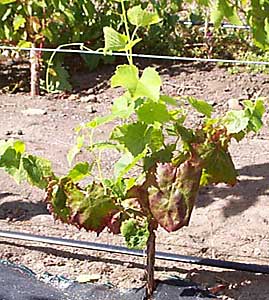Grapevine Virus A and B
 Causal Agent
Causal Agent
Grapevine Virus A (GVA) and Grapevine Virus B (GVB)
Hosts
The natural host range of GVA and GVB is grape, Vitis vinifera.
Symptoms
Grapevine Virus A (GVA) and Grapevine Virus B (GVB) are also called vitiviruses and are associated with the rugose wood complex diseases. Grapevines affected by this complex exhibit pitting and grooving under the bark. These viruses are generally transmitted by propagation of infected material.
Symptoms associated with GVA include reddening of leaf margins and petioles, poor vigor, and leafroll. The plant may exhibit swelling at the graft union and stem cracking. Ungrafted vines may be infected with GVA, but do not show visual symptoms. GVB causes corky bark, which can be seen when the bark on the trunk is removed. GVB only occurs in grafted vines.
Control
Growers should plant certified, disease-free plants. Pruning tools should be disinfected with a bleach solution (1 part household bleach, 9 parts water) between cuts. Infected plants should be removed and discarded.

